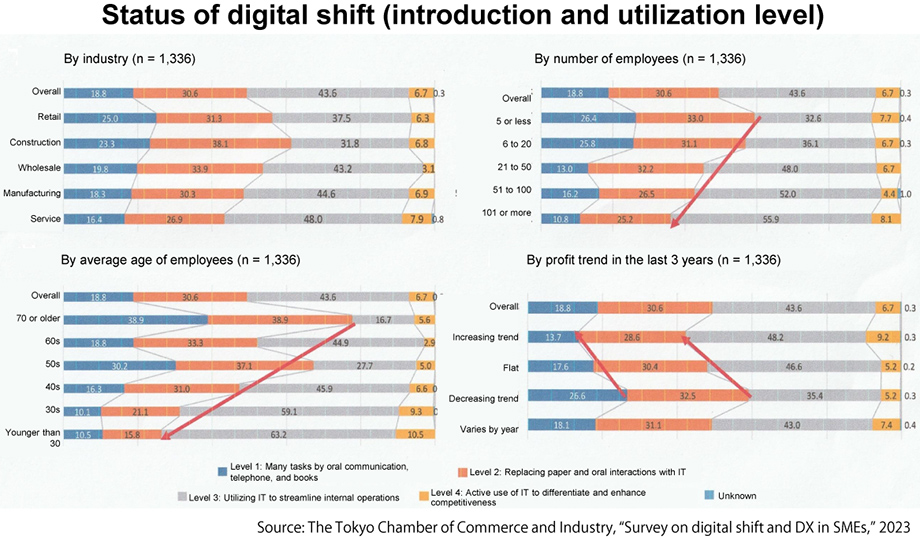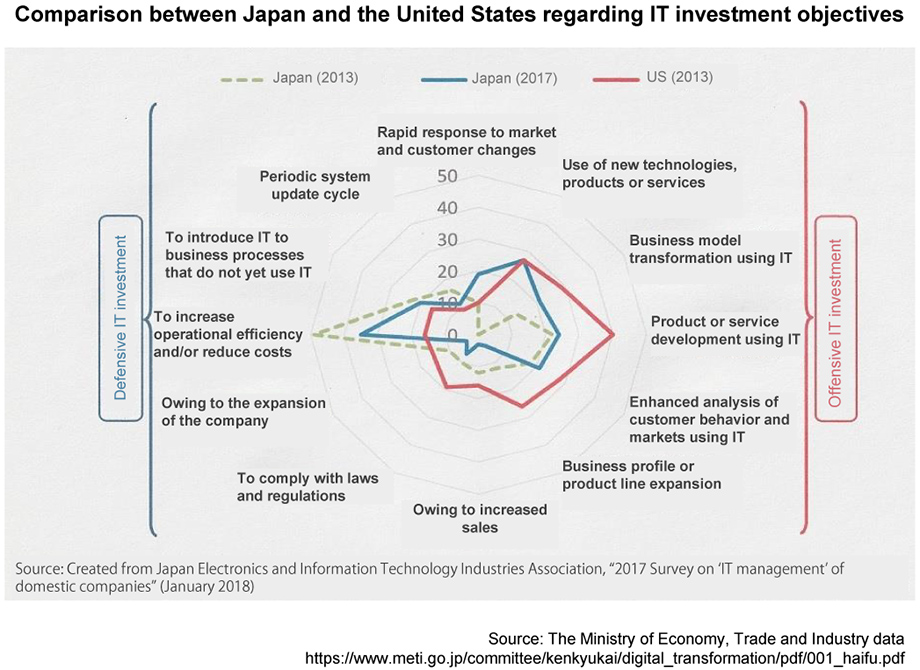Increasing efficiency is just a waypoint and not the goal of DX
Although Japan ranks third in the world so far in terms of GDP (gross domestic product), which is regarded as an indicator of economic power, many Japanese people do not actually feel its economic power. Although it is still maintaining its position, owing to the relatively large working population among advanced capitalist countries, Japan’s labor productivity per capita is by no means at the top of the list. According to material released by the Japan Productivity Center in December 2022, Japan ranked 29th out of 38 OECD (Organisation for Economic Co-operation and Development) member states.
Why is labor productivity so low in Japan? One reason is the lack of operational efficiency due to the poor use of information technology (IT) and the failure to translate IT into value-creating business activities that lead to increased sales and profits. Another factor is that the desire for “cheaper” has become excessive, and companies themselves have plunged into severe low-price competition. While they can confidently charge a fair price, they are lowering their profit margins. This could be an excessive spirit of hospitality. As a buyer, I appreciate it. However, if the business performance does not improve, the wages will not increase either, and the consumer purchasing power will not increase. This leads to a downward spiral in which the company’s performance does not improve because it cannot sell well what it made.
In order for Japan to become economically prosperous, it is essential to improve the labor productivity of SMEs, which account for 99.7% of Japanese companies. It has always been said that IT should be utilized to increase labor productivity since the basic act on IT was implemented in 2001.
However, even if IT can simply improve efficiency and reduce costs, that is not the DX that we aim for today. Increasing efficiency is just a waypoint and not the goal of DX. From there, they will further enhance their competitiveness and create added value. DX aims to increase the company’s potential and promote its growth. If improving efficiency and reducing costs are set as its goal, they will not grow further. I hope that many SMEs will understand this before taking steps to promote DX.
The status of IT utilization and awareness of IT investment are very different between Japan and the United States
The ownership ratio of personal computers for Japanese companies is currently more than 90%. Concerning smartphones, there are about twice as many subscriptions as the total population. Although the infrastructure has been developed, how is it being utilized? According to the Ministry of Economy, Trade and Industry’s data on the state of IT utilization by Japanese companies in 2008 (below), more than 60% are in Stage 2 or lower, meaning that they are not utilizing IT very well. Conversely, in the United States, more than 60% have reached Stage 3 or 4, which is called IT management. It is said that this trend has not changed so much since then.

Concerning the awareness of IT investment, until recently, most Japanese managers only focused on reducing costs and improving operational efficiency. If they invest with a sense of “defense” which is completed internally, sales will not increase. On the other hand, companies in the United States are investing in IT with the mindset of “offense” to increase performance by reaching out to the outside world by strengthening market analysis, using new technologies, developing new products and acquiring customers. It can be said that the difference in productivity between Japan and the US is the difference in whether IT is used to expand and realize its potential. That is, in contemporary terms, whether it is promoting DX after understanding what it is.
If a questionnaire is sent out asking how far digitalization has progressed toward DX, there will be subjective differences among the respondents. Therefore, the Tokyo Chamber of Commerce and Industry sent out a questionnaire to understand the actual conditions of SMEs at four levels based on how they conduct their daily business. The question asked about their current situation, which is categorized as level 1 if many tasks are done by paper and oral exchange, as level 2 if paper and oral exchange are replaced with IT, as level 3 if internal tasks are streamlined by using IT, and as level 4 if IT is used to increase competitiveness. (Below). As a result, about half of them appear to be level 3 or higher overall. However, the questionnaires were sent out to over 10,000 companies and about 1,300 companies answered. So, perhaps they were relatively conscious companies. This means, perhaps less than 30% of all are actually at level 3 or higher.

One of the two main factors for the lack of progress is the cost of IT implementation. This has been pointed out for 20 years. It is also because they do not understand the cost effectiveness. The other factor is the lack of personnel within the company who can promote DX. Small enterprises (with 20 or fewer employees in manufacturing industry; 5 or fewer in commercial and service industries) account for 85% of SMEs. It would be great if DX personnel could be trained internally, but it is physically difficult in the current situation.
The survival and development of SMEs through the promotion of DX will strengthen the Japanese economy
The promotion of DX by SMEs is far from advanced, but in terms of a larger trend, the mindset of managers is gradually changing to that of “offense.” Policy to support this is also in progress. For years, the Ministry of Economy, Trade and Industry has developed a measure to send specialists such as IT coordinators, who have obtained promotion qualifications created in 2001, without any charge. Today, support groups such as the Chamber of Commerce and Industry, the commerce and industry association, and the National Federation of Small Business Associations are focusing on accompanied support, and the environment for promoting DX is improving.

Moreover, public awareness activities have been developed nationwide. For instance, the Ministry of Economy, Trade and Industry carried out DX selection to select the best examples of DX from SMEs, etc., and the IT Coordinators Association offered ITCA Awards to recognize managers and IT coordinators who can serve as models for Japanese SMEs in promoting DX.
In 2020, the DX certification system was also launched, in which the national government certifies companies that are ready to work on the promotion of DX. Businesses which received the DX certification also benefit from various measures such as financial support, tax-related support, and human resource development support. Furthermore, if more companies aim to be certified, DX in Japan will accelerate. Therefore, the government is also making efforts to promote DX. Many have been forced to work from home or hold web meetings owing to the COVID-19 pandemic, and it is said that the mindset of managers has changed. It is desired that this trend will continue without interruption and further accelerate, and lead to the transformation of the company to become stronger.
To promote DX, it is important to change the mindset of management and change the organization. If IT is implemented as a tool and more efficiency is gained, each person will have more time to work on creative tasks and business will also grow. This will lead to the development of the company and will improve the lives of employees and their families. I believe that sharing such vision and employees working together as one will lead to corporate innovation.
The number of companies in Japan has been decreasing steadily. The number of SMEs has decreased from 4.21 million in 2009 to 3.82 million in 2014, and to 3.58 million in recent years. I mentioned earlier that SMEs account for 99.7% of Japanese companies. However, the ratio is even higher in regional areas. A country’s economy is a collection of local economies. If SMEs in regional areas are not doing their best, the Japanese economy itself will suffer.
The world keeps changing. If they do not do anything, they will be left behind in a changing society. To survive, they must change. The most effective tool for this purpose is IT, and DX is the contemporary way of making efforts to connect IT to corporate growth and development. Raising the level of SMEs by promoting DX will undoubtedly be the key to reviving the Japanese economy. For the sake of Japan, I would like to ask small and medium-sized business management to strengthen their individuality first.
* The information contained herein is current as of November 2023.
* The contents of articles on Meiji.net are based on the personal ideas and opinions of the author and do not indicate the official opinion of Meiji University.
* I work to achieve SDGs related to the educational and research themes that I am currently engaged in.
Information noted in the articles and videos, such as positions and affiliations, are current at the time of production.


